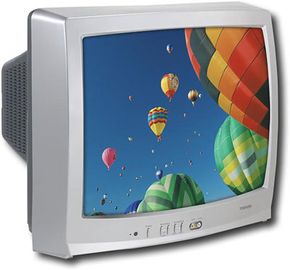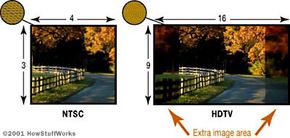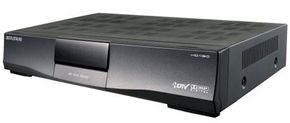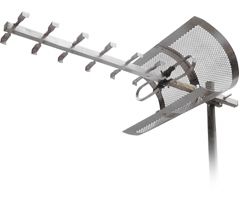When the first high-definition television (HDTV) sets hit the market in 1998, movie buffs, sports fans and tech aficionados got pretty excited, and for good reason. Ads for the sets hinted at a television paradise with superior resolution and digital surround sound. With HDTV, you could also play movies in their original widescreen format without the letterbox “black bars” that some people find annoying.
But for a lot of people, HDTV hasn’t delivered a ready-made source for transcendent experiences in front of the tube. Instead, people have gone shopping for a TV and found themselves surrounded by confusing abbreviations and too many choices. Some have even hooked up their new HDTV sets only to discover that the picture doesn’t look good. Fortunately, a few basic facts easily dispel all of this confusion.
In this article, we’ll look at the differences between analog, digital and high-definition, explain the acronyms and resolution levels and give you the facts on the United States transition to all-digital television. We’ll also tell you exactly what you need to know if you’re thinking about upgrading to HDTV.
Contents
Analog, Digital and HDTV
For years, watching TV has involved analog signals and cathode ray tube(CRT) sets. The signal is made of continually varying radio waves that the TV translates into a picture and sound. An analog signal can reach a person’s TV over the air, through a cable or via satellite. Digital signals, like the ones from DVD players, are converted to analog when played on traditional TVs. (You can read about how the TV interprets the signal in How Television Works.)
This system has worked pretty well for a long time, but it has some limitations:
- Conventional CRT sets display around 480 visible lines of pixels. Broadcasters have been sending signals that work well with this resolution for years, and they can’t fit enough resolution to fill a huge television into the analog signal.
- Analog pictures are interlaced — a CRT’s electron gun paints only half the lines for each pass down the screen. On some TVs, interlacing makes the picture flicker.
- Converting video to analog format lowers its quality.
United States broadcasting is currently changing to digital television (DTV). A digital signal transmits the information for video and sound as ones and zeros instead of as a wave. For over-the-air broadcasting, DTV will generally use the UHF portion of the radio spectrum with a 6 MHz bandwidth, just like analog TV signals do.
DTV has several advantages:
- The picture, even when displayed on a small TV, is better quality.
- A digital signal can support a higher resolution, so the picture will still look good when shown on a larger TV screen.
- The video can be progressive rather than interlaced — the screen shows the entire picture for every frame instead of every other line of pixels.
- TV stations can broadcast several signals using the same bandwidth. This is called multicasting.
- If broadcasters choose to, they can include interactive content or additional information with the DTV signal.
- It can support high-definition (HDTV) broadcasts.
DTV also has one really big disadvantage: Analog TVs can’t decode and display digital signals. When analog broadcasting ends, you’ll only be able to watch TV on your trusty old set if you have cable or satellite service transmitting analog signals or if you have a set-top digital converter.
This brings us to the first big misconception about HDTV. Some people believe that the United States is switching to HDTV — that all they’ll need for HDTV is a new TV and that they’ll automatically have HDTV when analog service ends. Unfortunately, none of this is true.
HDTV is just one part of the DTV transition. We’ll look at HDTV in more detail, including what makes it different from DTV, in the next section.
DTV vs. HDTV
The Advanced Television Standards Committee (ATSC) has set voluntary standards for digital television. These standards include how sound and video are encoded and transmitted. They also provide guidelines for different levels of quality. All of the digital standards are better in quality than analog signals. HDTV standards are the top tier of all the digital signals.
The ATSC has created 18 commonly used digital broadcast formats for video. The lowest quality digital format is about the same as the highest quality an analog TV can display. The 18 formats cover differences in:
- Aspect ratio – Standard television has a 4:3 aspect ratio — it is four units wide by three units high. HDTV has a 16:9 aspect ratio, more like a movie screen.
- Resolution – The lowest standard resolution (SDTV) will be about the same as analog TV and will go up to 704 x 480 pixels. The highest HDTV resolution is 1920 x 1080 pixels. HDTV can display about ten times as many pixels as an analog TV set.
- Frame rate – A set’s frame rate describes how many times it creates a complete picture on the screen every second. DTV frame rates usually end in “i” or “p” to denote whether they are interlaced or progressive. DTV frame rates range from 24p (24 frames per second, progressive) to 60p (60 frames per second, progressive).
Many of these standards have exactly the same aspect ratio and resolution — their frame rates differentiate them from one another. When you hear someone mention a “1080i” HDTV set, they’re talking about one that has a native resolution of 1920 x 1080 pixels and can display 60 frames per second, interlaced.
Broadcasters get to decide which of these formats they will use and whether they will broadcast in high definition — many are already using digital and high-definition signals. Electronics manufacturers get to decide which aspect ratios and resolutions their TVs will use. Consumers get to decide which resolutions are most important to them and buy their new equipment based on that.
Until the analog shutoff date, broadcasters will have two available channels to send their signal — a channel for analog, and a “virtual” channel for digital. Right now, people can watch an over-the-air digital signal only if they are tuned in to the broadcaster’s virtual digital channel. After analog broadcasting ends, the only signals people will receive over the air will be digital.
However, even though a digital signal is better quality than an analog signal, it isn’t necessarily high definition. HDTV is simply the highest of all the DTV standards. But whether you see a high-definition picture and hear the accompanying Dolby Digital® sound depends on two things. First, the station has to be broadcasting a high-definition signal. Second, you have to have the right equipment to receive and view it. We’ll look at how to get an HDTV set and signal next.
Buying an HDTV
The DTV transition is not the first change to the TV signal. In 1946, the National Television System Committee (NTSC) began setting standards for American broadcasting. In 1953, NTSC standards changed to allow color television, and in 1984, they changed to allow stereo sound.
Those changes were different from the DTV switch because they were backwards compatible — you could watch the new signal on your trusty old TV. With DTV, you’ll need some new gear, and the gear you choose will affect whether you can receive and view high-definition video. You can learn about buying a DTV set in How Digital Television Works — here, we’ll focus on HDTV.
When you start shopping, keep in mind that HDTV requires three parts:
- A source, such as a local, cable or satellite HDTV station
- A way to receive the signal, like an antenna, cable or satellite service
- An HDTV set
Most people start with the set. You can choose:
- An integrated HDTV, which has a digital tuner, also known as an ATSC tuner, built in. If a station near you is broadcasting in HDTV, you can attach an antenna to an integrated set and watch the station in high definition.
- An HDTV-ready set, also called an HDTV monitor, which does not have an HDTV tuner. HDTV-ready sets often have NTSC tuners, so you can still watch analog TV with them. This is the option for you if you want to have HDTV capabilities later on but aren’t ready for the financial commitment now. Your picture quality will still be better than on your old TV, but it won’t be high definition until you get an HDTV receiver.
Designing and building an HDTV that could display all of the ATSC formats would be virtually impossible. For this reason, HDTVs have one or two native resolutions. When the TV receives a signal, it will scale the signal to match its native resolution and de-interlace the signal if necessary. A good rule of thumb is to choose a set that has a native resolution matching the signals you plan to use most often. Film fans will generally want displays with the highest possible resolution. Sports fans will generally want displays with the highest possible progressive frame rate.
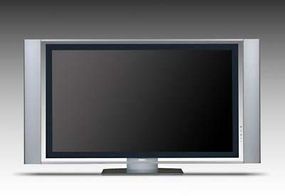
If you receive a signal that has a significantly lower resolution than your screen can display, all the extra pixels won’t help it look better. This is why some people who have bought HDTVs have been dismayed at the quality of the picture – the existing analog signal just doesn’t have enough detail to look good on a high-definition set. As broadcasters change to a digital signal, this problem will improve substantially.
In the next section, we’ll look at the options for getting a signal to your TV as well as the compatibility of your existing home entertainment equipment.
Equipment and Signal
When you’ve found an HDTV with a screen size, aspect ratio and native resolution you want, you’ll need to make sure the equipment you already own will work with it. If you already have a DVD player, a DVR, game consoles or other equipment, make sure that they can connect to the TV directly or through an audio/visual receiver. Many HDTVs have High-Definition Multimedia Interface (HDMI) connections, which can transmit audio/visual signals to the TV without compression. In some cases, you can use adapters to make your equipment compatible with your set.
Once you’ve picked up your set and installed it in your home, you’ll need to get a signal. To get a signal, you can use:
- An antenna – Depending on your location relative to the stations you want to watch, a set of rabbit ears might do, but you might need a rooftop or attic antenna. You can buy an antenna that’s specially made for digital signals, but any reliable VHF/UHF antenna will work.
- Cable – Keep in mind that digital cable is not the same as HDTV. You’ll need to check with your provider to determine which packages include HDTV stations. You’ll also either need a set-top cable box or a CableCARD™ to allow your television to receive and decode the cable signal.
- Satellite service – As with cable, check with your provider to determine which plans and stations use HDTV signals. You may need a different satellite dish and tuner to receive HDTV signals via satellite.
[“source=electronics.howstuffworks”]



